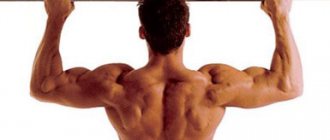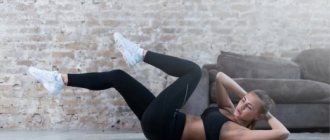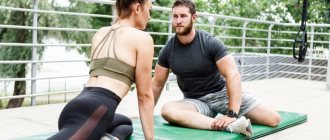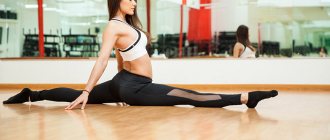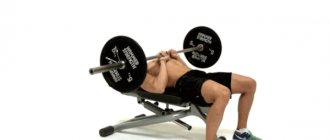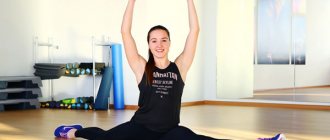© Syda_Productions — depositphotos.com
Share:
Every time you work out hard in the gym, your bones, ligaments, joints and muscle groups experience enormous pressure. This load remains even after the end of the workout. As a result, the bones begin to come into closer contact with each other, which creates an additional friction effect. In the long term, this can lead to negative consequences in the form of degenerative changes in joint and bone tissue. What to do to avoid such phenomena? To start, stretch after your workout.
Warm up before stretching
When you stretch after a workout, your muscles are already warmed up and no additional warm-up is required. If you decide to arrange a separate stretching lesson, first do a few exercises:
- Joint warm-up: twirl your joints, bend and twist your body.
- 5-7 minutes of cardio: running or Jumping Jacks, Rock Climber, running in place with high knees, jumping rope.
Once you've warmed up a bit, you can start stretching.
Do you need stretching?
Why is stretching the legs, like stretching the muscles of the shoulder joint after training, considered an unpleasant activity for many? Everything is simple here. Despite all the preventive benefits, stretching has some disadvantages. In particular, stretching reduces the strength performance of most athletes involved in speed-strength sports, including CrossFit. What is the biggest problem?
Let's study the physiology of ongoing processes in the human body. By performing heavy repetitions as part of strength training, the athlete stimulates the tightening of muscle tissue. This is achieved through myofibrillar hypertrophy, a slight hyperplasia of muscle tissue. But the most important thing is their location. Muscles that constantly work in one position develop heterogeneously and therefore receive a certain stiffness. Tightness in muscle tissue weakens the power impulse, as a result the athlete cannot lift serious weight.
If you don't believe this, think about why most powerlifters set records on special equipment, such as bench press shirts. The fact is that bench shirts compress muscle tissue and create an additional elastic impulse. This allows you to lift the weight 25-30% more without changing the trajectory and amplitude than without special equipment.
By regularly doing serious stretching, you reduce two main factors that help achieve the best results in the training process:
- Change the location of key fibers. As a result, your muscles become less tight, and therefore you need to exert significantly more effort to lift the same weight. In other words, stretching makes you somewhat weaker.
- You disrupt the processes of myofibrillar hypertrophy. Myofibrillar hypertrophy is a thickening of muscle tissue that is created solely by microtrauma to the muscles, followed by recovery through protein synthesis. When you stretch, you increase the size of the microtear, and the muscle tissue, instead of becoming thicker, becomes longer. This increases the volume of the muscles, but reduces their efficiency, since long muscles are a greater lever, and a greater lever means a greater distance and more effort that must be applied to lift the weight.
Therefore, if you are seriously involved in sports, think about prioritizing strength performance over injury prevention. Keep in mind that we are talking exclusively about serious stretching, be it splits or extreme complexes for developing arm flexibility. If you simply perform preventative low-intensity stretching, the influence of the negative factors of stretching on your body is almost completely neutralized, which allows you to achieve your goals painlessly.
This does not mean that your progress will not be slowed down, it’s just that the rate of deceleration will be extremely small compared to the rate of acceleration of anabolic weights, which you accelerate through exercise and proper nutrition in conjunction with full recovery after training.
How and how much to stretch
With these exercises, you can arrange an independent stretching session and thoroughly stretch all the muscles of your body. However, it will take about 60–90 minutes. For a quick stretch, choose one or two exercises for each muscle group involved in the workout.
To give your muscles a good stretch, hold each pose for 30 seconds to two minutes. You can remain still or gently spring. Sudden movements can cause injury, so leave them for another sport.
We will give exercises for stretching from top to bottom: neck, shoulders and arms, chest and back, abs, buttocks, thighs, legs.
Why is it important to stretch your muscles?
Regardless of what type of physical activity you prefer, make it a rule to regularly stretch your muscles after training. There are several reasons for this.
- Stretching improves muscle elasticity and joint mobility. This helps speed up the recovery process after exercise and reduces the risk of injury.
- Stretching improves blood circulation. This reduces soreness—muscle pain after physical activity. Stretching can also shorten the recovery time of muscles and joints.
- By doing a set of stretches as the final step of your workout, you restore your blood pressure and lower your heart rate. This allows you to smoothly return to the usual rhythm of life.
- Stretching helps release endorphins and provides a feeling of calm and satisfaction.
Photo: istockphoto.com
Personal experience: how stretching helped me get in shape
Neck stretching exercises
Tilt of the head back and to the side
Tilt your head back, stretching the front of your neck. From this position, tilt your head to the left. For greater effect, place your left palm on the right side of your head, but do not press hard.
Repeat the exercise on the other side.
Head tilt forward and sideways
Place your right hand on the left side of your head. Tilt your head forward and to the side, increase the pressure with your hand.
Repeat on the other side.
Back of the neck stretch
Place one hand on the back of your head and the other on your chin. Lower your head, making a double chin. At the same time, the neck remains straight, the back of the head tends upward. You should feel tension in the back of your neck, especially at the base of your skull.
What happens during stretching
Stretching after strength training is a necessary set of measures to avoid injury.
When stretching, the following happens:
- The muscles themselves stretch. This increases the size of microtraumas, which is especially useful when working in a pumping style, as it increases the likelihood and intensity of the manifestation of sarcoplasmic hypertrophy.
- The space between the bones increases, which can significantly reduce the risk of bone rubbing.
- The size of the glycogen depot increases through physical deformation.
- The joint space is stretched, which reduces the risk of leakage of interarticular fluid.
- Ligaments are stretched, which during heavy exercises provides a greater range of motion and sometimes allows you to break your technique without fear of sprains.
From a prevention point of view, stretching after training is as necessary an attribute for every athlete as warming up before training. However, among the majority of CrossFit athletes, powerlifters and some bodybuilders, there is a strong opposition to any stretching procedures other than stretching the spine using hanging on a horizontal bar.
© undrey — depositphotos.com
Shoulder stretches
Front Shoulder Stretch
Place your hands behind your back, clasp your wrist with one hand and the other. Bend your elbows and lift your wrists higher. Push your chest forward and feel the stretch in the front of your shoulders.
Mid Shoulder Stretch
Grab your opposite elbow with your hand, press your shoulder towards you and pull it down. Repeat with the other hand.
Back Shoulder Stretch
Grasp your right arm with your left above the elbow, press it to your body and straighten it, lower your right shoulder down. With your left hand, pull your right hand up, lifting it with your elbow. Feel the tension in the back of your shoulders.
Repeat with the other hand.
Triceps stretch
Go to the wall, lift your left elbow up, and place your forearm behind your back. Lower your left shoulder blade down. To check that it has actually dropped and will not rise during the stretch, place your right hand below your left armpit.
Repeat on the other side.
Biceps stretch
Grab a doorknob, counter, or other support and turn your back to it. Turn your elbow upward and move your body slightly forward.
Repeat with the other hand.
Triceps and Shoulder Stretch
This pose allows you to simultaneously stretch the triceps of one arm and the front of the shoulder of the other. Place one hand behind your back from above so that your elbow points upward, and the other from below so that your elbow points to the floor. Try to bring your wrists together behind your back at the level of your shoulder blades.
Switch hands.
Wrist Extensor Stretch
Sit on your knees, place your hands in front of you so that the backs of your hands touch the floor and your fingers point towards each other. Gently shift your weight into your hands, stretching your forearms. To enhance the effect, try clenching your fists.
Full body stretch sequence
Stretch your joints
Where to start training? Of course, from the warm-up. It is important to “wake up” all joints: neck, shoulders, elbows, lower back, hips, wrists, knees, ankles. This way you minimize injury.
Warm up your muscles
You need to train before stretching, because the muscles warm up and become more flexible. You can also put on extra workout clothing before stretching to help retain body heat longer. You will warm up well if you jump or do a light warm-up. Basic Stretch Stretch all muscles. Basic stretching exercises will prepare your body for more complex ones, such as the splits. Basic stretching reduces pain.
Main stretch (splits)
Increase your amplitude as much as possible, try doing the splits. Yes, you can use it carefully during the first lesson.
Chest stretching exercises
Chest stretch in the doorway
Approach the doorway, lean your elbows on the doorframes and push your chest forward, stretching your pectoral muscles.
Wall Chest Stretch
Place your hand on the wall, lower your shoulder and turn in the opposite direction. Repeat with the other hand.
What to do after stretching?
First of all, it is worth remembering that before intense stretching you did a workout, which means you need a standard set of recovery procedures.
- Restore water-salt balance with additional fluid.
- Close the protein window. Protein, isolate or split amino acids are perfect for this.
- Close the carbohydrate window. If the closing time of the protein window coincides with the carbohydrate window, it is recommended to take a serving of milk gainer. Otherwise, you can get by with fast carbohydrates, such as bananas.
- Provide emotional release.
And most importantly: after stretching, it is highly not recommended to go out into the cold. Muscle groups warmed up by training and pre-stretched during the stretching procedure are extremely susceptible to the constricting effects of cold. As a result, you can easily get pinched.
Back stretching exercises
Back stretch at the counter
Stand next to a rack, exercise machine or other support, turn your left shoulder towards it. With your right hand, grab the rack high above your head and move your pelvis to the right and down, stretching the entire right side of your body.
Repeat on the other side.
Stretching the lower back muscles
Sit on the floor, move your right leg forward, left leg back. Bend your knees at an angle of 90 degrees or slightly more. Place your right hand on the floor, raise your left above your head. Pull your left leg down and back, tilt your body forward and twist towards your right leg.
Switch legs.
Back extensor stretch
Sit on the floor, bend your knees and place your feet on the floor. Grasp your shins with your hands on the inside, place your wrists on your feet. Bend forward with a round back as low as possible.
Child's pose
Sit on the floor, buttocks should touch your heels. Lean forward, lie on your stomach on your knees and extend your arms.
Downward Facing Dog Pose
Get on all fours, then move your pelvis back and up so that your body resembles an angle. Your arms and back should be stretched out in one line, your knees can be bent, and your heels can be lifted off the floor. The main thing is that your back remains straight, without rounding in the lower back.
Hanging traction
Grab a low horizontal bar and hang freely, relaxing your body. Feet should remain on the ground. Relax them, bend your knees slightly.
Inverted back stretch
Lie on the floor on your back, arms along your body, legs straight. Raise your legs and then throw them behind your head. Hands rest with elbows on the floor, hands support the lower back. Do not lean on your neck, the fulcrum is your shoulders.
Technique: what and how to pull
Neck
Basic exercises for stretching the neck muscles will be tilting the head left and right and back and forth.
- To begin with, let's stand straight. Let's look ahead. Slowly pull your chin towards your chest as much as you can. When you reach the limit, try to lower your head a little further. And so on for 10–15 seconds.
- Then we throw our head back, trying to reach the back of our head. We continue to reach the back for 10–15 seconds. Keep your mouth closed, otherwise you will cheat.
- The most important muscles in this case are the lateral neck muscles. The starting position is the same as before. Raise your right hand and use it to pull your head to the right side. The right ear should reach towards the right shoulder. Make sure your shoulder doesn't move. When you feel the tension, continue the exercise and hold in the highest possible position for 20-30 seconds. Repeat the same for the other side of the neck. That is, with your left hand, pull your head with your ear to your left shoulder. Each hand pulls the head towards itself - this will make it easier to remember and understand the meaning of the exercise.
After everything, make several circular movements with your head in both directions.
Gently pull your head towards your shoulder.
Hands
We stretch the shoulders, flexors and extensors. You will need a wall bars or any vertical support.
We pull the shoulders and biceps like this:
- We stand with our right side to the support, stand straight.
- With the open palm of the right hand, we rest against the counter. The arm is straight and laid back slightly.
- We begin to turn the body to the left. At the same time, listen to yourself - move so that your right shoulder and biceps feel the stretch. Each person must find for himself the optimal direction of movement. Just listen to your feelings.
- We stretch as much as we can. We remain in the final position for up to 30 seconds.
We repeat the exercise for the left hand.
Find a position for yourself in which you can clearly feel the stretch. Turn your body in the opposite direction.
Here's how you can stretch your triceps:
- Raise your right arm up and bend it at the elbow joint. The palm of the right hand is located near the left shoulder.
- With your left hand, take your right elbow and gently pull it to the left.
- Hold the point of tension for 30 seconds and switch hands.
We stretch the triceps.
Breast
The chest is partially stretched along with the shoulders and biceps.
https://www.youtube.com/watch?v=r8lCjPgX6hM
You can stretch it like this:
- Approach the bars. Lean on them with both hands, as if you want to do push-ups. The feet are on the floor. It turns out that your elbows are raised high. This will be the starting position.
- We begin to slowly lower ourselves down as far as the pectoral muscles allow. Make sure that your body does not drop too low - you risk damaging the ligaments. Be guided by mild soreness.
- Stay in the final position for up to 30 seconds. It’s okay if instead of 30 there are 15–20.
Standing on the floor, grab the bars and lower your chest as low as possible.
Press
Abdominal stretching is done like this:
- Lie on your stomach. Place your hands as if you want to do push-ups from the floor.
- Straighten up on your arms as if you were doing a push-up. Keep your pelvis on the floor. Arch up as much as you can. Hold the final state for up to 30 seconds.
- If you feel pain in your back, try to bend until you feel comfortable. Gradually the pain should go away and you will be able to bend more.
Try to press your pelvis to the floor.
Back, lower back and back of thighs
Upper back:
- We stand up straight, bend our chest forward, and move our pelvis back. We breathe evenly. We begin to bend our back in the chest, arching it back as far as we can. We bring our shoulders forward, stretch our arms forward and down. The chin follows the hands.
- We stretch our arms as far as we can and return to the opposite position. There is no need to pause here. We experience tension in the muscles near the shoulder blades. If it’s not there, we try to adjust the movement so that the sensations are there.
The upper back stretches between the shoulder blades.
Lower back and back of thighs:
- The starting position is the same as in the previous exercise. The main thing here is the bend in the lower back. Buttocks pulled back! This is very important for girls, since this posture visually attracts all men.
- Maintaining all the bends, trying to keep the knees straight, we begin to stretch our hands to the floor. The goal is to touch your toes with them.
- We recommend not to violate the arch in the lower back. If you cannot even reach your ankles initially, be patient and gradually you will be able to achieve this.
The back should be straight.
Why shouldn't you arch your back? Then you will reduce the effectiveness of this exercise and increase the likelihood of injury. Many people, arching their back, can easily reach their shoes with their hands. But the muscles do not stretch - such exercise is useless.
Legs, splits
In order to do the splits, stretching must be done intensively. Here are exercises that will help you achieve your desired goal.
Knee extension:
- Starting position – sitting (buttocks on the floor), legs in front of you and bent at the knees. The knees are moved to the sides.
- Feet together, try to move them 15-20 cm forward from you.
- We begin to press on our knees with our hands, trying to lower them to the floor. Over time, you will be able to touch your knees to the floor. We do it through a little pain. We linger in this state for 30 seconds.
You can press on your knees with your hands, or you can do this.
Legs to the sides (cross split):
- Upon completion of the first exercise, we stand up and spread our straight legs to the sides as wide as we can. You can hold onto the support with your hands.
- Gradually we spread them even wider. Over time, if you want to do the splits, you will need to ask your partner for help. He will gently press on you from above. But this will happen later, when you have 10-15 cm left before reaching the floor. In the meantime, maintain the lowest possible position for 30 seconds. Can be repeated several times.
The goal is cross splits.
Legs back and forth (longitudinal splits):
- From a standing position, we step as far forward as possible with one leg, and move the other back. Both legs are straight. We push them as far back and forth as we can.
- We linger in the final position for 30 seconds. Can be repeated.
Full longitudinal twine.
Remember, muscle stretching after training is a basic element, without which there will be no effective training.
Abdominal stretching exercises
Camel Pose
Get on your knees, push your chest up, lengthening your spine, and then lean back, placing your hands on your heels. Try to bend in the thoracic region. Don't throw your head back, look up.
Upward-facing dog pose
Lie on the floor on your stomach, place your hands under your shoulders. Push yourself up, your pelvis rises, your legs remain on the floor. Lower your shoulders, bend in the chest.
Standing Backbend
Stand straight with your feet together. Raise your arms and join your palms above your head. Bend your chest and tilt your body back. Tighten your buttocks to prevent a strong arch in your lower back.
Side tilt
Stand up straight, raise your arms above your head, clasp your fingers and turn your palms up. Stretch up and bend first to one side and then to the other.
Lying spinal twist
Lie on the floor on your back, arms out to the sides, palms down. Move your pelvis to the left, lift your left leg, bending it at the knee, move it behind your right leg and try to place your knee on the floor. Turn your head to the left and relax.
Repeat the exercise on the other side.
Lower back stretch
Lie on your back and bend your knees. Feet together, arms apart. Gently begin to tilt both knees from side to side as far as possible. You should not experience discomfort, but only feel a stretching in the lower back. Do 5-10 bends in each direction.
Why it is important to do this exercise: The lower back is also loaded during long periods of walking, running and sitting still.
Exercises for stretching the buttocks
Lying stretch
Lie on the floor on your back, raise your knees bent. Place the ankle of your left foot on the knee of your right. Press the knee of your right leg onto your left to deepen the stretch. Repeat with the other leg.
Stretch on all fours
Get on all fours, place your right ankle on your left knee. Push your pelvis back to deepen the stretch. Repeat with the other leg.
Stretching while sitting
Sit on the floor, stretch your legs forward, straighten your back. Bend one leg at the knee, grab your shin with your hands and press it to your chest. The shin should be parallel to the floor, the forearms lie on top and press it to the chest, one hand covers the other.
Repeat with the other leg.
Pigeon pose
Sit on the floor, bend one leg at the knee at a right angle and move it forward, take the other back and straighten it. You can lean forward and place your forearms on the floor.
If you have difficulty doing this pose on the floor, try placing your foot on an elevated platform.
Hamstring stretch
Lie on your back. Extend your left leg straight straight up. Holding your left hip with both hands, gently pull your leg toward you. Hold this position. You should feel a stretch on the back of your knee. Repeat for the other leg.
Why is it important to do this exercise: the hamstrings are especially stressed in cardio running, walking on a stepper, exercising on an exercise bike and cycling. Pay proper attention to your knees after training like this to avoid future injuries.
Exercises to stretch the front of the thigh
Lying quadriceps stretch
Lie on the floor on your stomach, lift one leg and place your hand on your ankle. Pull your leg towards your buttock, trying not to lift your thigh off the floor. Repeat with the other leg.
Single Knee Quadriceps Stretch
Get down on one knee, grab the toe of your back leg with your hand and pull your heel towards your buttock. Squeeze your gluteal muscles: this will deepen the stretch. Repeat with the other leg.
Hip flexor stretch
Get on one knee with both legs bent at a 90-degree angle. The back is straight. Tighten your gluteal muscles and move your pelvis slightly forward. You should feel tension in the front of your back leg and in your groin.
Switch legs.
Deep Lunge
Take a deep lunge forward. Place your fingers on the floor on either side of your foot. Lower the knee of the straightened leg to the floor. Try to go lower and do not turn your pelvis to the side.
Switch legs.
Gluteal stretch
Lie on your back. The left leg is extended vertically upward, the right leg is bent at the knee joint and touches the left knee in front. Grab your left thigh with both hands and pull it slightly towards you. Hold this position. Repeat for the other leg.
Why is it important to do this exercise: the gluteal muscles support us during running, stepper exercises and other exercises that actively involve the legs. It is especially worth paying attention to stretching the buttocks for people engaged in sedentary work.
Photo: womensfitness.co.uk; pexels.com/Li Sun
Exercises to stretch the back of the thigh
Hamstring stretch with expander
Lie on the floor, leave one straight leg on the floor, raise the other. Place an expander, jump rope or rope over your foot and pull your leg towards you. Switch legs.
Stretching while standing
Stand up straight, take a step forward. Tilt your body almost parallel to the floor. If you leave the leg straight, the upper part of the back of the thigh is stretched more; if you slightly bend the leg at the knee, the lower part is stretched.
Repeat with the other leg.
Tilt to feet
Sit on the floor, stretch your legs straight forward. Bend towards your feet and place your hands on either side of your feet or slightly further away. To deepen the stretch, you can straighten your back for a few seconds and then bend down again.
Bend to one leg
Sit on the floor, stretch one leg forward, bend the other at the knee and place your foot next to your pelvis. Bend towards your straight leg, grab your foot with your hands and pull the toe towards you. Try not to round your back.
Repeat with the other leg.
Bend while standing
Spread your legs wider, toes pointing forward. Lower your body down, keeping your back straight, until you place your palms on the floor.
Longitudinal twine
Split into a side split so that your iliac crests point forward. Place your palms on the floor and support your body weight on your hands. Try not to turn your hips and shoulders to the side.
Basic Rules for Stretching After a Workout
Stretching, like any other physical activity, has its own characteristics and rules. It is important to study them before you start classes.
Keep it regular
It is important to do stretching exercises after each workout for 5-10 minutes to reduce muscle tension. At least once a week you should do a longer stretch of all muscles, devoting 20-30 minutes to it.
Give preference to static
After playing sports, stretching should be static. “Springy” movements and strong pressure on the working muscle should be avoided. This does not apply to workouts that only include stretching.
Don't exclude massage from your training plan
You need to remember that despite the fact that stretching has a beneficial effect on your muscles, it is not a replacement for massage. Therefore, for regular training, it is recommended to use a massage roller.
Breathe deeply
Deep breathing promotes better muscle stretching, blood circulation, relaxation and helps avoid injury. Inhale deeply and stretch as you exhale.
Photo: istockphoto.com
Stretch within your capabilities
If some movement is given to you with pain and through “I can’t”, you should not try to perform it perfectly here and now. Perform the exercises smoothly, do not rush. Over time, the muscles will get used to regular stretching and it will become easier to exercise.
Watch your posture
Do not round your back while bending towards your feet. Try to reach your hips with your stomach. If you can't cope, ask someone to help you and apply a little pressure in the lumbar region. Otherwise, there is a risk of harming the spine.
5 simple exercises that will relieve fatigue in the body and stretch muscles
Inner Thigh Stretching Exercises
Deep squat
Stand next to a rack or machine that you can hold on to. Feet shoulder-width apart, toes and knees turned outward. Lower yourself into a deep squat, keeping your back straight.
Butterfly near the wall
Sit on the floor with your back straight, fold your legs in front of you with your feet facing each other. Try to lower your knees to the floor, but do not put pressure on them with your hands. Keep your back straight.
Frog
Lie on the floor on your stomach, spread your knees to the sides and bend your legs at a right angle. Try to place your pelvis on the floor.
Frog with straight leg
Lie on the floor on your stomach, spread your knees out to the sides so that your thighs are parallel to the floor. Bend one leg at the knee, straighten the other. Try to place your pelvis on the floor. Repeat with the other leg.
Forward fold
Sit on the floor, spread your straight legs wider, and then lean forward. Try to lie on your stomach on the floor, do not bend your knees.
Cross twine
vova130555/ru.depositphotos.com
Split into a cross split. Do not move your pelvis too far back; ideally it should be in line with your knees and feet. Place your palms on the floor, and if stretching allows, your forearms. Pull your pelvis down towards the floor.
Stretching next to the wall
Lie on the floor close to the wall. The body should be perpendicular to it. Spread your legs and let them slowly lower under your weight. Stay in this position for 5–10 minutes.
Spinal stretch
How to do it: Place the ogi shoulder-width apart, with your knees slightly bent. Cross your arms in front of you and grab the inside of each thigh. Arch your back, rounding your spine from the cervical to the lumbar region, lowering (hiding) your head. This exercise helps relieve back tension.
How many times to perform: one approach for 15–30 seconds, repeat as necessary.
5 common dietary mistakes that prevent you from losing weight Read
Exercises to stretch the outer thigh
Hip abduction
Stand next to a wall, turning your right side towards it. Place your right leg behind your left and squat down. The left leg bends, the right leg remains straight and moves further to the left. The straight body hangs over the left leg.
Repeat on the other side.
Stretching while standing
Place your left leg behind your right in front and lean to the left. You can place one hand on your belt, fold your arms above your head or in front of you. The more the body tilts, the better the muscles stretch.
Hip flexor stretch
Lunge forward with your right leg, touching your left knee to the ground. Reach forward until you feel a stretch in your right thigh. Don't bend over, keep your body straight. Hold the position. Repeat for the other leg.
Why this exercise is important: The hip flexors are involved in exercises and sports that involve lifting the legs and bending the knees. These flexors will become clogged, which can lead to pain in the hips and lower back.
Calf Stretching Exercises
Stretch against the wall
Press the toe of your right foot against the wall, take your left foot a step and a half back. The feet are pressed tightly to the floor, the left leg is straight. Try to reach the wall with your right knee, this will stretch the muscles of your left leg.
Switch legs.
Heel Wall Stretch
Stand close to the wall. Place your right toe on the wall, take your left leg a step and a half back. Bend your left leg at the knee, increasing the stretch. Switch legs and repeat.
Biceps stretch
Exercise for the biceps brachii muscle:
- Hook your fingers on a doorframe or other similar surface with your elbow facing up and your thumb pointing down. The hand is parallel to the floor.
- Move your body forward a little.
- Repeat for the other hand.
Why do you need stretching after training and how to stretch correctly?
Health, Interview
October 12, 2020
By: Marina Dianova
Stretching after a workout is a must for everyone. Why is it dangerous to ignore stretching? How to do it correctly? How to avoid harming yourself while stretching? In this article, gymnast, blogger and author of stretching courses Savina Aksinya . On her Instagram , Aksinya shares a video with full-body stretching workouts, and also describes in detail the technique of longitudinal and transverse split exercises.
— Stretching reduces the risk of injuries during exercise, lengthens muscles, makes ligaments more elastic, increases joint mobility, improves blood circulation and, importantly, promotes the production of happiness hormones! By devoting just 10-15 minutes to stretching after all exercises, you help your muscles recover faster, thereby making your workout more productive and speeding up the muscle building process. For beginners in the gym, stretching is simply necessary, because they are the ones who most often suffer from muscle pain - soreness. Moreover, in today's sedentary world, stretching is needed not only as an addition to strength training. If you do not lead an active lifestyle, then by doing stretching exercises you can avoid many injuries in everyday life and prevent tension in your body.
Stretching after strength training is not a full stretching workout, but rather a finishing step. As with any other exercise, stretching has a set of rules that must be followed to avoid injury while performing it.
Only stretch after warming up
After strength training, your muscles and joints are already warmed up and ready to perform stretching exercises. In this case, you do not need to do a warm-up, but you can start stretching right away. If you do stretching separately from classes in the gym, then do not forget to start it with a short warm-up.
Joint warm-up is an integral part of stretching
The first exercises must be aimed at working with joints: rotation of the head, shoulders, pelvis, knees, ankles. The main reason for the need to perform a joint warm-up is to prevent joint injuries during basic exercises, preparing the body for stretching and further work.
Perform exercises without sudden movements
Stretching is relaxation of our muscles, so all exercises should be performed smoothly, with a natural exhalation, without holding your breath.
Stretching should not cause severe pain
It is normal to feel stretched muscles, ligaments and tendons and a slight nagging pain during stretching. As soon as you feel stabbing pain or discomfort in the muscles, you should stop doing the exercise. Try repeating the exercise after a few minutes, being sure to listen to your body.
Relaxation is a must!
While performing the exercises, you should not clamp or strain your muscles; this approach will not bring the desired results, and in some cases it can even cause harm. When taking stretching positions, try to pay special attention to relaxing not only your head, but also your body.
Do stretching exercises regularly
Classes once a week are unlikely to bring you the desired result; a sufficient number of classes is from 2 to 4 times a week. Remember that it is better to spend at least 10 minutes stretching after each workout than to spend half an hour once a week.
Do exercises to the best of your physical ability
By tightening your muscles you are doing more harm to your body than good. If a static exercise specifies a fixed execution time, then you do not need to increase it yourself, thereby overloading yourself and leading to exhaustion. The goal of the workout is to stretch the muscles, not damage them.
Types of stretching
There are several types of stretching, differing in intensity, duration, and ligament work. The most basic types of stretching:
Static
When performing static stretching exercises, you freeze in one position and remain in it for 20 seconds to several minutes. Static stretching involves a very gentle stretching of muscles, ligaments and tendons, which allows you to easily determine the level of intensity and depth of each exercise.
Benefits of static stretching: This type of exercise allows you to stretch quite quickly, the exercises are very smooth and slow, which minimizes the risk of injury while doing it. This type of stretching is ideal for beginners.
Dynamic
Dynamic stretching is completely the opposite of static stretching, in which exercises are aimed at amplitude and numerous repetitions. This type of stretching is more complex, so I do not recommend it to beginners without constant supervision from a trainer. In dynamic stretching exercises, it is very important to control the amplitude and sharpness of movements so as not to harm your body.
Benefits of Dynamic Stretching: This type of stretching helps improve endurance in strength training, increases strength and power, but as mentioned above, it requires more concentration and control.
What is the best stretch to do after a workout?
I recommend that my students do static stretching after training, especially if you have never done this before. If you are confident in your strengths and capabilities, then you can combine both types (static and dynamic stretching), but do not forget to control your movements and be as careful as possible.
For me, stretching has long been the key to beauty and health. I advise absolutely everyone to do it, regardless of age and gender. Do not neglect stretching after training, be sure to devote 10-15 minutes to it and after just a few workouts you will feel all the benefits of stretching. Feel your body, don’t exhaust yourself, and most importantly, exercise according to your inner feelings. Try to introduce stretching into your daily life and your body will be immensely grateful to you for this useful habit. I wish you productive training and will be glad to see you on my blog on Instagram !
Author: Savina Aksinya, artistic gymnast, stretching coach, blogger
Dynamic stretching
Represents swing and rotational movements.
Don't confuse dynamic stretching with ballistic stretching! Ballistic stretching uses jerking motions, while dynamic stretching uses gentle, gentle movements.
Start with light movements, gradually increasing the range of motion. Do not do this too harshly, otherwise you risk damaging your joints. Movements should be soft and smooth.
Exercises: swinging arms and legs, twisting the body.
What is recovery?
Restoration is traditionally understood as a one-stage model - when something lost is returned (8) or something returns to its original state (9). However, in sports, recovery from physical activity is a two-stage model - when what was lost is restored (for example, fatigue is reduced) and adaptation (supercompensation) to increased demands (6). Taking this into account, recovery is not complete until the athlete has reached a level of training that exceeds baseline values (the principle of supercompensation). Figure 2 shows this principle in a simplified form.
Standing stretch for men
Among other things, stretching for men helps maintain healthy joints. Since cartilage tissue and connections are not supplied with blood, the only way to bring nutrients to them is to perform a series of special exercises. Regular exercises maintain general mobility of the limbs and also prolong the “youth” of the spinal column.
The proposed exercises are universal, so they are suitable for both men and women. If you do stretching on a separate day, and not after a workout, we recommend starting the session with joint gymnastics.
Standing stretching time for men:
- 15 seconds in each pose on each side => total standing stretch duration ~10 minutes
- 20 seconds in each pose on each side => total standing stretch duration ~13 minutes
- 30 seconds in each pose on each side => total standing stretch duration ~18 minutes
- 45 seconds in each pose on each side => total standing stretch duration ~30 minutes
Neck bends to the side
Why : Warming up the neck helps stimulate blood flow to the brain, relaxes the cervical spine, which is especially important for people with a sedentary, inactive lifestyle.
How to do it : Tilt your head to the right and hold in this position, slightly helping yourself with your hand and increasing the stretch of the neck muscles. Take your time while working and avoid sudden movements. Then repeat on the other side.
Neck bends forward
Why : Another element for stretching the neck muscles and the corresponding part of the spine. Exercise also helps improve blood flow to the brain and relieves pain.
How to do it : Gently tilt your head forward, helping yourself with the pressure of both palms on the back of your head. Watch closely for pain, avoiding it in the process. Avoid sharp bends.
Side bends
Why : The classic element of school warm-up is aimed at stretching the latissimus muscles, as well as the lateral parts of the body.
How to do it : Raising your arm up, bend in the opposite direction, exhaling. Stay in this position without leaning your body forward. The legs are placed along the delta line.
Shoulder stretch
Why : This is a mandatory stretching exercise for men at home, which allows you to prepare your shoulders for physical activity, or relax them after a hard workout.
How to do it : Move your arm to the side as far as possible, applying additional force with your other arm. Feel the stretch in your shoulder muscles.
Wrist flexion
Why : The presented element allows you not only to stretch the wrist joint, but also to work the muscles of the biceps and forearm, which athletes often do not pay due attention to.
How to do it : With your arm extended in front of you, bend your hand so that your palm points forward. Apply gentle pressure with your other hand to increase tension.
Putting your hands behind your head
Why : An effective element for stretching the triceps and posterior deltoids. Additionally, the latissimus muscle is included in the work.
How to do it : Raising your arm, bend it at the elbow so that your palm is behind your head. Grab the fingers of the abducted hand with the other limb and begin to lightly pull it in the other direction.
Triceps stretch
Why : Exercise similar to the previous one. It allows you to effectively stretch your triceps and shoulders, relieving pain and tension from the corresponding muscle groups.
How to do it : Raising both arms, bend one so that your palm reaches the bottom of the cervical spine. With your other hand, apply gentle pressure to your elbow, thereby increasing the stretch.
Raising your hands clasped behind your back
Why : This stretching element for beginners perfectly stretches the front fascicles of the shoulders and pectoral muscles. Additionally, the biceps are involved in the work.
How to do it : With your hands clasped at the back of your lower back, begin to slowly lift them without bending your body. Carefully monitor the position of your head, avoiding tilting forward and to the sides.
Raising arms to the sides
Why : Another exercise for high-quality stretching of the pectoral muscle group. Also in the process, the biceps of the arms, forearms, and the front parts of the deltoids are stretched.
How to do it : The stretching element for men at home is extremely simple. Raising your arms to the sides, begin to move them back with great effort, while maintaining the natural arch of your back.
Side bends with hands above
Why : In this particular case, work is carried out on both sides of the body at once. The latissimus muscles, arms, and lateral areas are stretched. Excellent support for back health.
How to do it : Raise your arms above your head, clasping them together. Bend as far as possible to the side, feel a pleasant stretch throughout your entire upper body. If you find it difficult to bend over, you can simply raise your arms above your head without bending over.
Calf pull-up
Why : This is an effective way to stretch your quadriceps without the risk of knee injury. Calf raises are especially beneficial after leg strength training.
How to do it : Bend one leg so that you grab your foot with your hand. By applying extra force with your hand, you increase the tension, which makes the large muscle stretch much more effectively.
Knee pull-up
Why : A stretch element that acts directly on the back of the thigh. The buttocks can also be stretched, which makes the exercise especially useful before/after leg training.
How to do it : Standing on the floor, lift one knee, additionally pressing it with both arms. The higher the limb rises, the stronger the effect on the thigh biceps.
Back bend
Why : This is a must-have exercise for people with an inactive lifestyle and sedentary work. With its help you can maintain a healthy back and lower back. The abdominal muscles are additionally stretched.
How to do it : With your hands on your waist, straighten up, gently arching your body back. For convenience, you can tilt your head slightly. Fix the position, gradually increasing the tension with the strength of the lumbar muscles.
Standing back rounding
Why : This is another extremely useful exercise for people with an inactive lifestyle and sedentary work. Perfectly relieves tension from the back and lower back.
How to do it : Lower yourself into a half-squat and bend over, rounding your back. Cross your arms between your legs and place them behind your hips. Increase the tension by wrapping your hands around your inner thigh.
Knee Lunge
Why : A complex exercise that uses the leg muscles as well as the lower back. Good stretch for the back of the thigh and calves. Great for warming up the knee joint before squats or running.
How to do it : Taking a small step forward, lean on your knee while maintaining an even posture. Additional load is provided due to low-amplitude swaying.
Straight Leg Lunge
Why : This simple stretching exercise for men focuses on stretching the hamstrings and calf muscles. Also involves the knee joint in work.
How to do it : Taking a small step, rest your foot on your heel, then gently press on your knee with both palms. After completing the set, switch sides.
Lunge forward
Why : This stretching element for men requires preparation, but it remarkably stretches both the back and front of the thigh.
How to do it : Take a long step forward, then squat down, leaning on your working knee with both hands. You can perform rocking movements “1-2-3”. Don't forget to do it on the opposite side.
Side Lunge
Why : An indispensable stretching exercise for beginners, focusing on the inner thigh.
How to do it : Spread your legs wider than your shoulders, then transfer your body weight to one leg and squat. You can increase the tension by pulsating on the count “1-2-3”.
Tilt with straight legs
Why : One of the best exercises for stretching all the muscles of the back and legs. It stimulates blood flow to the brain, which is especially important for people with a sedentary lifestyle.
How to do it : With your feet shoulder-width apart, lean forward. Try to place your palms on the surface of the support in front, keeping your back straight. This could be a chair, bedside table, wall bars. To make it easier, you can spread your legs wider.
If stretching allows, you can bend towards the floor:
Downward facing dog
Why : A more complex and complex variation of the inclination, necessary for stretching the calf muscles, hamstrings, latissimus dorsi, lumbar region. An excellent exercise for a healthy spine.
How to do it : From a plank position, lift your pelvis up, trying to form a triangle. To keep your back straight, you can bend your knees slightly and lift your heels off the floor. Secure your body in a downward-facing dog position, feeling the stretch throughout your body.
Warm up before training
Before strength training, you need to perform a set of exercises aimed at fully warming up the whole body. A general warm-up for the whole body also includes pre-workout stretching.
Start by warming up your fingers and hands, then move on to your elbows and shoulders. After this, stretch your neck, torso, lower back, hip area, thighs, knees, ankles and toes.
Rotation in the joints will allow them to cope with loads with greater ease. Movements should be smooth and soft. Avoid sudden movements, otherwise you risk damaging the joint before training.
Next, begin static stretching, which will make your muscles more elastic. Start with the back, then move to the upper body (neck, forearms, wrists, chest, triceps), and then to the lower body (buttocks, groin, quads, hamstrings, ankles, calves and feet).
PNF stretching
PNF – proprioceptive neuromuscular facilitation. The essence of this method is to relax the target muscle group after tension. It is the most effective and fastest option for increasing static-passive flexibility.
It is a combination of passive stretching and isometric stretching. First, the muscles undergo passive stretching, which is then replaced by a phase of isometric contraction in a stretched position with resistance, and then passive stretching with increased amplitude comes into play again.
The effectiveness of this technique will increase if you have a partner to help you perform the exercises. He will create isometric resistance and then perform a passive movement with an increased range of motion.
The muscles being stretched should relax for 20 seconds before the next stretch.
Types of PNF stretches
Contraction-relaxation
At the beginning of the exercise, after passive stretching, you should contract the muscle isometrically for 7–15 seconds. Then let it rest for a couple of seconds, then immediately repeat the passive stretch, but with more force. The final stretch should last 10–15 seconds.
It is the safest type of PNF stretching.
Contraction-relaxation-contraction
The first part of the exercise repeats the contraction-relaxation principle: an isometric contraction for 7-15 seconds and a short rest. While resting the muscle being stretched, you need to isometrically contract the antagonist of the target muscle for 7 to 15 seconds. Then let your muscles rest for 20 seconds.
Contraction-relaxation-maximum
This technique is recommended for use if you feel like an experienced athlete who has excellent control over the muscle reflexes of his body. Otherwise, you risk injury.
The first part is similar to the contraction-relaxation technique, but the final stage of the exercise uses dynamic or ballistic stretching.
Common mistakes when doing stretching
- Insufficient warm-up.
The muscles are not yet ready to stretch, because they have not yet warmed up. During the process of forced stretching, the risk of injury increases.
- Lack of rest between sets.
It happens that the muscle has not yet recovered from the previous load, and it is loaded again. You should not do this, because it can lead to muscle fatigue.
- Excessive stretching.
Don't overdo the stretching. Don't forget that you want to improve your muscle elasticity, not do another hard workout.
- Incorrect sequence of exercises.
If you mix up the sequence of actions, the muscles will not get the desired effect from the exercises. In addition, due to rash actions, you can easily get injured.


